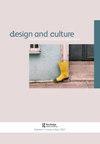Design, Nature, and Revolution: Toward a Critical Ecology
IF 0.7
3区 艺术学
0 ART
引用次数: 2
Abstract
ation to reflect on Jacqueline’s late-1940s upholstery designs for Jacques’ furniture, when he had to restrain opulence and conceive more economical designs for the living spaces and furnishings of Britain’s middle class, as well as for collective forms of living. This chapter also addresses Jacques’ diminishing creative opportunities in the 1950s and his progressive mental health challenges. Prokop must be credited for resisting the temptation to establish causality between the two. Jacqueline’s story continues after Jacques’ sudden death: she worked for another twenty-five years and the last chapter also describes her achievements in the designs for abstract textiles and applied textiles for the interiors of ships, trains, and planes. Prokop has gathered an impressive amount of information and presents a thrilling story of the partially forgotten Groags. (A complete list of the Groags’ projects and an accessible bibliography is also useful for resuscitating the pair’s design careers.) Her emphasis on Jacques’ life and career may owe to a lack of historical and archival documents relating to Jacqueline, but still the book might have asked more questions associated with feminist criticism. For example, what obstacles did Jacqueline have to overcome in her career that Jacques did not? How did the imperative of unpaid housework and caretaking in the broader sense, stereotypically assigned to women, influence her career? Attending to these questions might have opened up space for further consideration of the relationship between the couple’s work. For example, considering what collaboration looked like in the day-to-day and how artistic exchange could or did take place might have helped us understand even more about the differences in their bodies of work as well as what connects it, beyond their shared last name.设计、自然与革命:走向批判生态学
反思杰奎琳20世纪40年代末为雅克家具设计的室内装潢,当时他不得不抑制奢华,为英国中产阶级的生活空间和家具以及集体生活形式构思更经济的设计。本章还论述了雅克在20世纪50年代日益减少的创作机会和他不断进步的心理健康挑战。普罗科普抵制了在两者之间建立因果关系的诱惑,这一点值得称赞。雅克突然去世后,杰奎琳的故事仍在继续:她又工作了25年,最后一章还描述了她在抽象纺织品设计和船舶、火车和飞机内饰应用纺织品方面的成就。Prokop收集了大量令人印象深刻的信息,并讲述了一个关于被部分遗忘的Groags的激动人心的故事。(Groags夫妇项目的完整清单和可查阅的参考书目也有助于重振两人的设计生涯。)她对Jacques的生活和职业生涯的强调可能是因为缺乏与Jacqueline有关的历史和档案文件,但这本书可能提出了更多与女权主义批评有关的问题。例如,杰奎琳在她的职业生涯中需要克服哪些雅克没有克服的障碍?在更广泛的意义上,无偿家务和照顾的必要性是如何影响她的职业生涯的?关注这些问题可能会为进一步考虑这对夫妇的工作关系开辟空间。例如,考虑到日常合作的样子,以及艺术交流是如何进行的,这可能有助于我们更多地了解他们作品中的差异,以及除了共同的姓氏之外,还有什么联系。
本文章由计算机程序翻译,如有差异,请以英文原文为准。
求助全文
约1分钟内获得全文
求助全文

 求助内容:
求助内容: 应助结果提醒方式:
应助结果提醒方式:


